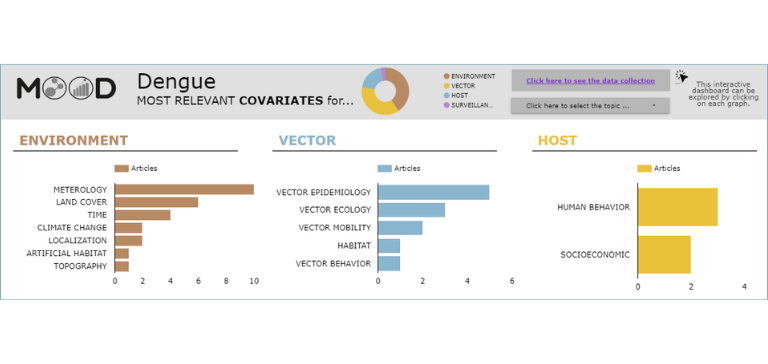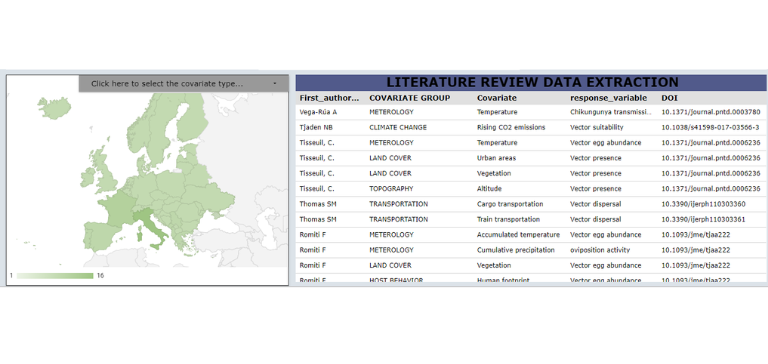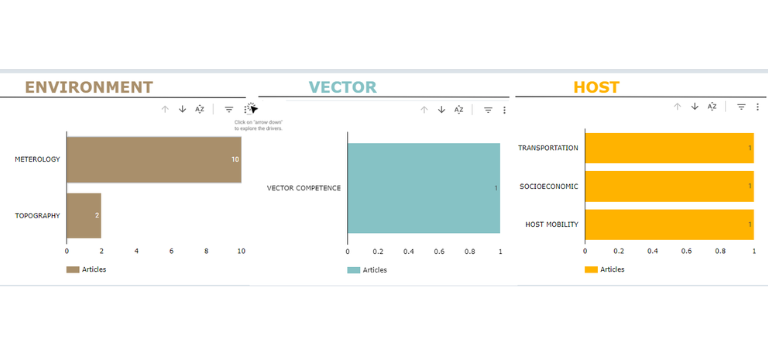Dengue (DEN) and Chikungunya (CHIK), exotic pathogens transmitted by invasive vectors
Disease description

Dengue virus (DENV), belonging to the Flavivirus genus, is the arbovirus with the broadest impact on human health. It is primarily transmitted to humans through the bite of infected Aedes mosquitoes, particularly Aedes aegypti and Aedes albopictus. While the dispersal of DENV is partially conditioned by environmental factors that influence the distribution of its main vectors, Aedes albopictus has become a competent vector for DENV and is now established in numerous regions of Europe. Viremic travelers arriving in Europe from dengue-endemic areas have contributed to local outbreaks and autochthonous cases. The first autochthonous transmission in Europe was reported in France in September 2010, and new cases have continued to emerge annually.
Before 2020, dengue was mostly limited to tropical regions, with sporadic European cases linked to travelers from endemic areas. By 2020, Europe saw few cases due to reduced travel and less favorable mosquito conditions.
However, the situation changed markedly in 2022, with France reporting about 65 autochthonous cases, driven by increased travel and favorable climatic conditions. The trend worsened in 2023, with over 90 cases and at least 12 outbreaks in France. The problem intensified in 2024, with a record 120 autochthonous cases and 15 outbreaks, including a severe one in the Rhône department.
To address the challenges posed by dengue and support public health efforts in prevention, surveillance, risk assessment, and vector control, MOOD has dedicated a case study to dengue. The objective of this study is to design and develop sustainable risk modeling and mapping tools to improve the understanding of and response to emergence risks associated with exotic mosquitoes-borne diseases.
DEN Covariates Dashboards
Fig 1-2: Simulations of spatial and dynamic mosquito population dynamics for the exploration of DEN covariates
This tool allows users to simulate spatial and dynamic mosquito population dynamics, as well as epidemiological transmission processes. The graphical user interface and the underlying model are based on the French Arbocarto tool and modeling approach (https://www.arbocarto.fr/en). The model has been expanded to include additional epidemiological features and outputs. Designed for field operators, the tool aids in defining and optimizing vector control protocols, enhancing their ability to manage and respond to mosquito-borne disease risks effectively.
Fig 3: A snippet of the dashboard for the exploration of DEN covariates
This tool allows us to explore metadata about environmental and ecological covariates adopted in literature, with respect to Dengue emergence in Europe. The dashboard is based on the results of a scientific literature review performed on articles published between 2010 and 2022.
Disease profile
To reach a comprehensive understanding of the factors affecting the ecology, distribution, and trend in Europe of the infectious diseases included in MOOD, information from the available literature and expert input was collected and summarized in “disease profiles”. These documents synthesize the available knowledge on specific diseases, such as Dengue (In Press).
Case study leader

CIRAD, Animal Health Territories Risks Ecosystems (join research unit ASTRE, https://umr-astre.cirad.fr/en), Hammami Pachka (pachka.hammami@cirad.fr)
For more video content about Dengue
Due to climate change and globalization the risk of introduction and expansion of exotic arthropod vectors, such as Aedes albopictus, and autochthonous transmission of arboviruses, like dengue virus, has increased in Europe. In 2022, sixty-five autochtonous cases of dengue were identified in metropolitan France. This increase is largely attributed to the geographical expansion of the vector Aedes albopictus. To prevent the emergence of those vector-borne diseases, there is a need to better identify and prioritize high-risk territories and periods to implement targeted prevention and vector control. Pachka Hammami and her team developed a multi-level model including the population dynamics of Aedes albopictus mosquitoes in a temperate environment and the epidemiological dynamics of dengue. They presented a Graphical User Interface (GUI) designed to support surveillance and control of arboviruses in Europe. Based on the developed model, the R/Shiny application provides a facilitated way to run complex simulations taking into account spatial and temporal variability in temperature and rainfall as well as spatial variation in land cover, population density and mobility patterns. The tool allows users to easily design and test epidemiological scenarios. Visualization tool for exploring the simulated outputs includes key figures summaries, epidemic curves, spatial visualization of inputs, risk maps, and temporal curve of epidemic indicators. Presentation held by Pachka Hammami, modeler and epidemiologist, during the latest edition of the MOOD Science Webinar on September 27th 2023.
Disease description

Chikungunya virus (CHIKV), belonging to the Alphavirus genus, is transmitted to humans via the bite of infected Aedes mosquitoes. First identified during the 1952 outbreak in Tanzania, the disease was initially confined to localized epidemics in Africa and Southeast Asia. However, in recent decades, CHIKV has expanded its geographical range globally and now poses an emerging public health threat. Non-endemic regions, including Europe, have reported both imported and local cases, largely due to the establishment of the competent vector, Aedes albopictus, in over 25 European countries, alongside favorable environmental conditions. The increase in international travel and trade further heightens the risk of CHIKV introduction and local transmission, making autochthonous outbreaks more likely.
In response to these growing challenges, MOOD has launched a case study focused on chikungunya, aimed at supporting public health efforts in prevention, surveillance, risk assessment, and vector control. The study seeks to evaluate the impact of climate and land-use changes on the emergence of CHIKV in Europe and assess future risk scenarios.
Disease profile
To reach a comprehensive understanding of the factors affecting the ecology, distribution, and trend in Europe of the infectious diseases included in MOOD, information from the available literature and expert input was collected and summarized in “disease profiles”. These documents synthesize the available knowledge on specific diseases, such as AMR (In Press).
CHIK Covariates Dashboards
Case study leader

Spatial Epidemiology Lab (SpELL, https://spell.ulb.be/), Kyla Serres (kyla.serres@ulb.be)
For more video content about Chikungunya
Due to climate change and globalization the risk of introduction and expansion of exotic arthropod vectors, such as Aedes albopictus, and autochthonous transmission of arboviruses, like dengue virus, has increased in Europe. In 2022, sixty-five autochtonous cases of dengue were identified in metropolitan France. This increase is largely attributed to the geographical expansion of the vector Aedes albopictus. To prevent the emergence of those vector-borne diseases, there is a need to better identify and prioritize high-risk territories and periods to implement targeted prevention and vector control. Pachka Hammami and her team developed a multi-level model including the population dynamics of Aedes albopictus mosquitoes in a temperate environment and the epidemiological dynamics of dengue. They presented a Graphical User Interface (GUI) designed to support surveillance and control of arboviruses in Europe. Based on the developed model, the R/Shiny application provides a facilitated way to run complex simulations taking into account spatial and temporal variability in temperature and rainfall as well as spatial variation in land cover, population density and mobility patterns. The tool allows users to easily design and test epidemiological scenarios. Visualization tool for exploring the simulated outputs includes key figures summaries, epidemic curves, spatial visualization of inputs, risk maps, and temporal curve of epidemic indicators. Presentation held by Pachka Hammami, modeler and epidemiologist, during the latest edition of the MOOD Science Webinar on September 27th 2023.






